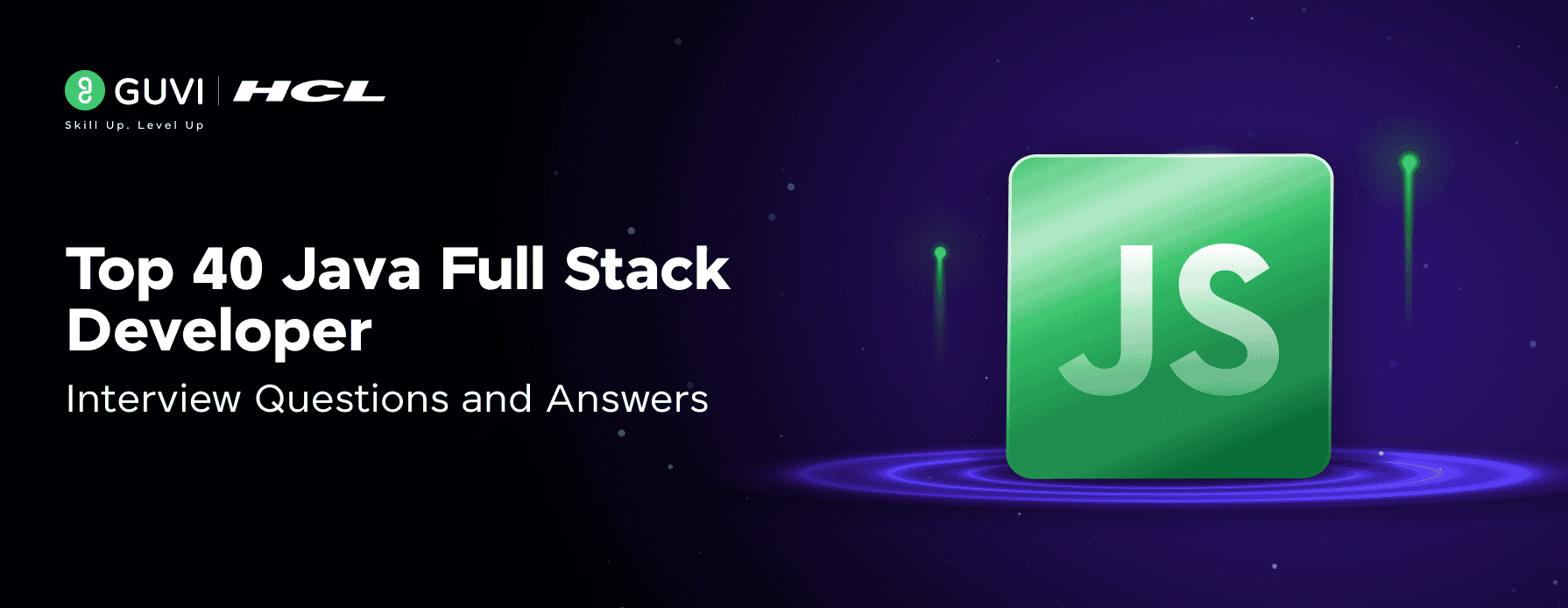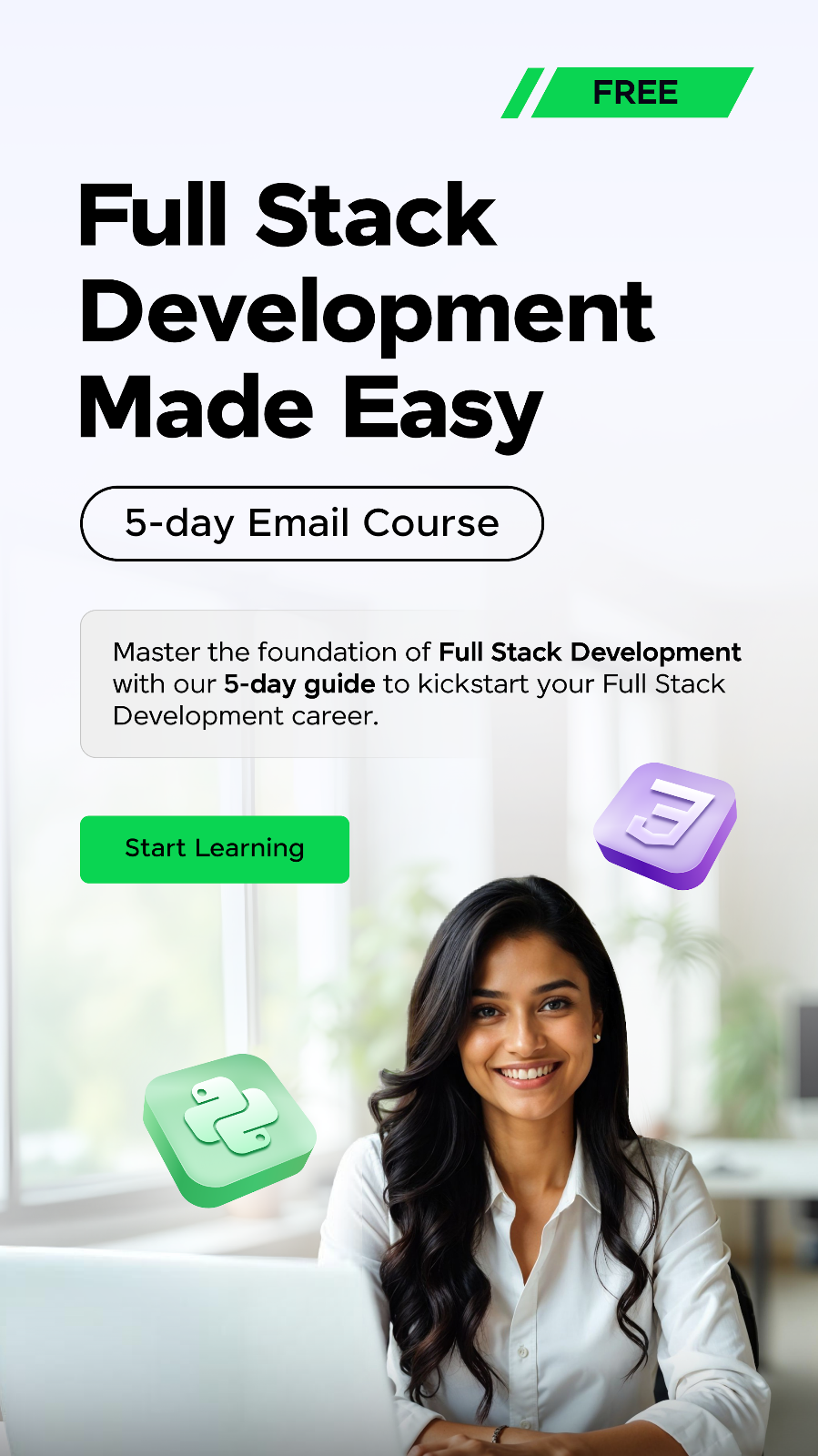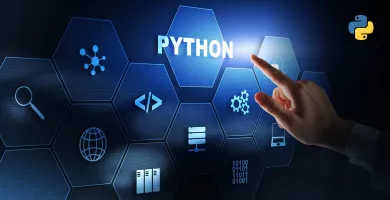
Top 40 Java Full Stack Developer Interview Questions and Answers [2025]
Sep 17, 2025 8 Min Read 5958 Views
(Last Updated)
Do you have a Java Full Stack Developer interview coming up and aren’t sure how to prepare? Don’t worry, you’re in the right place. This guide will not only cover the most commonly asked interview questions but also provide answers, preparation tips, and insights for both freshers and experienced candidates.
Full-stack Java developers are expected to handle everything, from core Java concepts to frontend frameworks, databases, and cloud services. Top companies like Microsoft, Accenture, and Infosys are always on the lookout for professionals who can demonstrate this versatility.
In this guide, you’ll find:
- Top 40+ Java Full Stack Developer Interview Questions and Answers
- Separate sections for Freshers and Experienced candidates
- Interview preparation tips to help you stand out
Let’s dive in.
Table of contents
- Java Full Stack Developer Interview Questions: Core Java and Backend Concepts
- What are the key features of Java?
- What is the difference between JDK, JRE, and JVM?
- What is a class in Java?
- What is the Singleton pattern?
- What is the difference between HashMap and ConcurrentHashMap?
- What is a functional interface?
- What is the use of final, finally, and finalize?
- What is multithreading in Java?
- Java Full Stack Developer Interview Questions: Spring, Hibernate, and Database Questions
- What is Spring Boot?
- What is the use of @RestController?
- What is Dependency Injection?
- What is Hibernate, and why is it used?
- What is lazy loading in Hibernate?
- What is the ACID property?
- What is the difference between save() and persist()?
- What is the role of @Transactional?
- Java Full Stack Developer Interview Questions: Frontend and Web Technologies
- What is the virtual DOM in React?
- What is two-way binding in Angular?
- What are lifecycle hooks in Angular?
- What is the difference between props and state?
- What is AJAX, and how does it work?
- What is the DOM?
- What is the difference between HTML and HTML5?
- What are CSS selectors?
- Java Full Stack Developer Interview Questions: Security, DevOps, and Architecture
- What is CORS, and how is it resolved?
- How do you secure a full-stack application?
- What is Docker, and its benefits?
- What is CI/CD, and why is it important?
- What is the difference between monolithic and microservice architecture?
- What is the Circuit Breaker pattern?
- What is session-based vs token-based authentication?
- What is the role of cloud services like AWS in full-stack development?
- Java Full Stack Developer Interview Questions: Real-World and Scenario-Based Questions
- How do you optimize performance in a full-stack app?
- How do you debug a slow-loading page?
- How do you handle version control in a team?
- How do you manage API errors in production?
- How do you test REST APIs?
- How do you handle cross-browser compatibility?
- How do you stay updated with full-stack trends?
- What are your go-to tools as a Java full-stack developer?
- Java Full Stack Developer Interview Tips
- Concluding Thoughts…
Java Full Stack Developer Interview Questions: Core Java and Backend Concepts
Mastering core Java concepts is fundamental for any full-stack developer interview. Interviewers often begin with these foundational questions to assess your technical knowledge.
![Top 40 Java Full Stack Developer Interview Questions and Answers [2025] 1 java full stack developer interview questions and answers](https://www.guvi.in/blog/wp-content/uploads/2025/06/Core-Java-and-Backend-Concepts@2x-1200x630.png)
1. What are the key features of Java?
Java stands out due to its powerful features that make it ideal for enterprise applications:
- Platform Independence: Java follows the “Write Once, Run Anywhere” principle through its bytecode execution
- Object-Oriented: Supports core OOP concepts including inheritance, encapsulation, and polymorphism
- Automatic Memory Management: Handles garbage collection automatically
Java’s simplicity and consistent object model make it easier to learn compared to other languages used for server applications.
2. What is the difference between JDK, JRE, and JVM?
These three components serve different purposes in the Java ecosystem:
| Component | Purpose | Contains | Used By |
| JDK | Development Kit | JRE + development tools (compiler, debugger) | Developers |
| JRE | Runtime Environment | JVM + libraries to run applications | End users |
| JVM | Virtual Machine | Executes bytecode, platform-specific | Included in JRE |
JDK is platform-dependent with separate installers for different operating systems. JVM is the heart of Java, converting bytecode to machine-specific code.
3. What is a class in Java?
A class in Java is a blueprint from which individual objects are created. It defines a set of attributes (fields) and behaviors (methods) that the objects will possess.
Classes form the foundation of object-oriented programming in Java, enabling you to create multiple objects with similar properties.
4. What is the Singleton pattern?
The Singleton pattern ensures a class has only one instance while providing global access to it. This pattern is useful for database connections, configuration settings, or any resource that should be instantiated only once.
5. What is the difference between HashMap and ConcurrentHashMap?
The primary differences include:
- Thread Safety: HashMap is not thread-safe, while ConcurrentHashMap is designed for concurrent access
- Performance: HashMap generally performs better in single-threaded environments
- Null Values: HashMap allows one null key and multiple null values; ConcurrentHashMap doesn’t allow any null keys or values
- Iteration: HashMap throws ConcurrentModificationException if modified during iteration; ConcurrentHashMap uses fail-safe iterators
6. What is a functional interface?
A functional interface in Java is an interface with exactly one abstract method. These interfaces serve as the foundation for lambda expressions.
7. What is the use of final, finally, and finalize?
Despite their similar names, these serve entirely different purposes:
- final: Keyword that restricts modification (variables can’t be changed, methods can’t be overridden, classes can’t be extended)
- Finally: Block in exception handling that always executes regardless of whether an exception occurs
- Finalize: Method called by the garbage collector before an object is destroyed (deprecated in newer Java versions)
8. What is multithreading in Java?
Multithreading allows multiple threads of execution to run concurrently within a single program. This improves efficiency by utilizing CPU resources better. You can implement multithreading in Java by:
- Extending the Thread class
- Implementing the Runnable interface
Threads in Java go through various states: New, Runnable, Waiting, Timed Waiting, and Terminated. Proper thread synchronization is essential to avoid race conditions in shared resources.
Java Full Stack Developer Interview Questions: Spring, Hibernate, and Database Questions
Framework expertise is crucial for any Java full-stack developer interview. Questions about Spring, Hibernate, and databases frequently appear in technical assessments, regardless of experience level.
![Top 40 Java Full Stack Developer Interview Questions and Answers [2025] 2 Java Full Stack Developer Interview Questions: Spring, Hibernate, and Database Questions](https://www.guvi.in/blog/wp-content/uploads/2025/06/Spring-Hibernate-and-Database@2x-1200x630.png)
9. What is Spring Boot?
Spring Boot is a project built on top of the Spring Framework that simplifies Java application development. It eliminates boilerplate configuration through:
- Autoconfiguration: Automatically configures the application based on dependencies
- Standalone: Creates applications that “just run” without external web servers
- Opinionated defaults: Provides starter dependencies for common use cases
Spring Boot makes developing web applications and microservices significantly faster by handling the tedious setup, allowing you to focus on business logic rather than configuration.
10. What is the use of @RestController?
@RestController is a convenience annotation in Spring that combines @Controller and @ResponseBody. This powerful annotation:
- Marks a class as a request handler for RESTful web services
- Automatically converts returned objects to JSON or XML responses
- Eliminates the need to annotate each method with @ResponseBody
- Simplifies the creation of APIs by handling content negotiation
11. What is Dependency Injection?
Dependency Injection (DI) is a core concept in Spring where objects receive their dependencies from an external source rather than creating them. There are two primary types:
Constructor Injection: Dependencies provided through constructor arguments
Setter Injection: Dependencies provided through setter methods
DI promotes loose coupling between components, makes testing easier, and allows Spring to manage object lifecycles effectively.
12. What is Hibernate, and why is it used?
Hibernate is the most widely used Object-Relational Mapping (ORM) framework for Java that bridges the gap between object-oriented code and relational databases. It’s used because it:
- Maps Java objects to database tables automatically
- Simplifies CRUD operations with minimal code
- Provides database independence
Hibernate significantly reduces boilerplate database code while maintaining performance and data integrity.
13. What is lazy loading in Hibernate?
Lazy loading is a design pattern in Hibernate that defers the initialization of an object until it’s needed. This optimization:
- Loads associated entities only when explicitly accessed
- Reduces initial load time and memory consumption
- Uses proxies to represent unloaded relationships
14. What is the ACID property?
ACID is a set of properties that guarantee database transactions are processed reliably:
- Atomicity: Ensures transactions are all-or-nothing (either completely successful or failed)
- Consistency: Guarantees that transactions bring the database from one valid state to another
- Isolation: Makes sure concurrent transactions don’t interfere with each other
- Durability: Ensures that committed transactions remain permanent even after system failures
These properties are fundamental to maintaining data integrity in relational databases, especially in enterprise applications handling critical information like financial transactions.
15. What is the difference between save() and persist()?
Both methods store entities in the database, but have important differences:
| Feature | save() | persist() |
| Return type | Returns generated ID (Serializable) | Returns void |
| Outside transaction | May execute immediately | Waits for transaction |
| Detached entities | Creates duplicate | Throws exception |
| Origin | Hibernate-specific | JPA standard |
The persist() method is primarily used within transaction boundaries, whereas save() can work outside them but might create duplicate entities when used with detached objects.
16. What is the role of @Transactional?
The @Transactional annotation in Spring manages database transactions declaratively. When applied to a method or class, it:
- Automatically begins a transaction before method execution
- Commits the transaction if the method completes successfully
- Rolls back the transaction if exceptions occur
Java Full Stack Developer Interview Questions: Frontend and Web Technologies
Frontend knowledge is equally important for Java full-stack developer interview questions as many companies expect versatility across the technology stack. Let’s explore crucial web concepts that often appear in technical interviews.
![Top 40 Java Full Stack Developer Interview Questions and Answers [2025] 3 Java Full Stack Developer Interview Questions: Frontend and Web Technologies](https://www.guvi.in/blog/wp-content/uploads/2025/06/Frontend-and-Web-Technologies@2x-1200x630.png)
17. What is the virtual DOM in React?
The virtual DOM is a lightweight copy of the real DOM that React uses to optimize rendering performance. It works through a three-step process:
- When a component’s state changes, React creates a new virtual DOM tree
- React compares this new tree with the previous one using a diffing algorithm
- Only the actual differences are then applied to the real DOM
This selective updating approach is significantly faster than manipulating the entire DOM directly, resulting in a better user experience and application performance.
18. What is two-way binding in Angular?
Two-way binding in Angular creates a synchronization between the model (component class) and the view (template). When data changes in either location, both are automatically updated. Angular implements this using the [(ngModel)] directive, which combines property binding [] and event binding () in a single notation. For example:
<input [(ngModel)]=”username” placeholder=”Enter username”>
<p>Hello, {{username}}!</p>
This functionality requires importing the FormsModule from @angular/forms.
19. What are lifecycle hooks in Angular?
Lifecycle hooks are special methods that Angular calls at specific points in a component’s lifecycle. The primary hooks include:
- ngOnInit: Called once after component initialization
- ngOnChanges: Runs when input properties change
- ngDoCheck: Called during change detection
- ngAfterContentInit: Executes after content projection
- ngAfterViewInit: Runs after the component’s view initializes
- ngOnDestroy: Called before component destruction
These hooks allow developers to perform actions at specific times in a component’s existence.
20. What is the difference between props and state?
Props and state are both used for data management in React, yet serve different purposes:
- Props are passed from parent components, are immutable, and are read-only
- State is managed within the component, mutable, and can be updated using setState()
- Props enable parent-child communication while state handles local component data
- Props can be used with both functional and class components
- State was traditionally limited to class components (before React Hooks)
21. What is AJAX, and how does it work?
AJAX (Asynchronous JavaScript and XML) enables web applications to send and receive data from servers without refreshing the entire page. This approach reduces server traffic and improves application responsiveness.
22. What is the DOM?
The Document Object Model (DOM) is a programming interface that represents HTML documents as a tree structure. Each element becomes a node in this tree, allowing scripts to:
- Access and modify document content
- Change element styles and attributes
- Respond to user interactions
- Create dynamic web experiences
The DOM essentially connects web pages to scripts, enabling interactive applications.
23. What is the difference between HTML and HTML5?
HTML5 introduced significant improvements over traditional HTML:
- Native multimedia support (audio/video tags) without plugins
- New semantic elements (header, footer, nav, section)
- Local storage options beyond cookies
These enhancements made HTML5 more suitable for modern web applications and mobile devices.
24. What are CSS selectors?
CSS selectors are patterns used to select and style HTML elements. The main types include:
- Element selectors: Target specific HTML tags (e.g., p)
- Class selectors: Select elements with specific classes (e.g., .container)
- ID selectors: Target unique elements (e.g., #header)
- Attribute selectors: Match elements with specific attributes (e.g., [type=”text”])
- Pseudo-class selectors: Target elements in special states (e.g., :hover)
Selectors can be combined with various combinators like descendant (space), child (>), and adjacent sibling (+) to create more specific targeting patterns.
Java Full Stack Developer Interview Questions: Security, DevOps, and Architecture
Modern Java full-stack development demands expertise in security, architecture, and deployment practices that go beyond coding skills. These concepts frequently appear in advanced interview questions.
![Top 40 Java Full Stack Developer Interview Questions and Answers [2025] 4 Java Full Stack Developer Interview Questions: Security, DevOps, and Architecture](https://www.guvi.in/blog/wp-content/uploads/2025/06/Security-DevOps-and-Architecture@2x-1200x630.png)
25. What is CORS, and how is it resolved?
Cross-Origin Resource Sharing (CORS) is a security mechanism that restricts web pages from making requests to domains different from the one that served the original page.
To resolve CORS issues:
- Configure your server to send appropriate CORS headers
- Implement a proper CORS policy that only allows specific origins
- For development purposes, use proxy servers or browser extensions
26. How do you secure a full-stack application?
Securing full-stack applications requires a comprehensive approach:
- Implement strong authentication and authorization (OAuth2, JWT)
- Apply input validation on both the client and server sides
- Use HTTPS for all communications
- Encrypt sensitive data both in transit and at rest
27. What is Docker, and its benefits?
Docker is a platform that packages applications and dependencies into containers. Its benefits include:
- Portability: Containers run consistently across different environments
- Isolation: Applications run independently without interference
- Efficiency: Uses fewer resources compared to traditional VMs
28. What is CI/CD, and why is it important?
Continuous Integration and Continuous Delivery/Deployment (CI/CD) automate the software development process
CI/CD is important as it:
- Detects bugs earlier in development
- Accelerates release cycles
- Improves code quality through automated testing
29. What is the difference between monolithic and microservice architecture?
| Aspect | Monolithic | Microservices |
| Structure | Single unified unit | Collection of independent services |
| Deployment | Entire application deployed | Services deployed individually |
| Scaling | Simpler initially, but complex over time | Individual services can scale |
| Development | Simpler initially but complex over time | More complex setup, easier maintenance |
| Technology | Limited technology choices | Freedom to use different technologies |
| Fault tolerance | One component failure affects all | Services can fail independently |
30. What is the Circuit Breaker pattern?
The Circuit Breaker pattern prevents an application from repeatedly attempting to execute operations likely to fail. Like an electrical circuit breaker, it:
- Monitors for failures in calls to services
- Trips open after reaching a failure threshold
- Allows limited test requests after a timeout period
- Automatically resets when service recovers
This pattern improves system stability by failing fast and providing fallback mechanisms.
31. What is session-based vs token-based authentication?
Session-based authentication stores session information on the server after user login, while token-based authentication relies on signed tokens containing user information.
Key differences:
- Session: Stores state on server; uses cookies; works well for server-rendered apps
- Token: Stateless; stored on client; ideal for SPAs and mobile apps
- Scalability: Tokens scale better in distributed systems
- Security: Sessions are vulnerable to CSRF; tokens can be compromised if stolen
32. What is the role of cloud services like AWS in full-stack development?
Cloud services like AWS fundamentally transform how Java full-stack applications are built and deployed:
- Provide managed infrastructure without hardware maintenance
- Offer database services, authentication, storage, and compute resources
- Enable automated scaling based on demand
Java Full Stack Developer Interview Questions: Real-World and Scenario-Based Questions
Scenario-based questions reveal your practical problem-solving abilities that employers value most in Java full-stack developer interviews. These questions test your real-world experience beyond theoretical knowledge.
![Top 40 Java Full Stack Developer Interview Questions and Answers [2025] 5 Java Full Stack Developer Interview Questions: Real-World and Scenario-Based Questions](https://www.guvi.in/blog/wp-content/uploads/2025/06/Real-World-and-Scenario-Based-Questions@2x-1200x630.png)
33. How do you optimize performance in a full-stack app?
Optimizing full-stack applications requires a multi-layered approach. Focus on these high-impact strategies:
- Implement advanced caching with Redis for frequently accessed data, which can reduce operational costs by up to 70%
- Replace REST APIs with GraphQL to minimize over-fetching and reduce bandwidth usage
- Optimize database queries through proper indexing and connection pooling
34. How do you debug a slow-loading page?
Start by using performance analysis tools like GTmetrix for desktop and PageSpeed Insights for mobile testing. Examine the waterfall chart to identify which assets take the longest to load. Look for common issues like unoptimized images, excessive HTTP requests, or render-blocking scripts.
35. How do you handle version control in a team?
Establish consistent workflows using clear branching strategies. Encourage frequent, atomic commits that focus on a single task or fix. Write descriptive commit messages starting with a present-tense verb that clearly explains the purpose. Implement code reviews before merging to shared repositories. Define standard practices for the entire team to follow, such as GitFlow or trunk-based development.
36. How do you manage API errors in production?
Implement structured error responses following RFC 9457 standards. Include clear error codes, descriptive messages, and suggested actions. Set up comprehensive monitoring to track error rates and resolution times. Avoid leaking sensitive data in error messages. Document common errors in your API documentation. Use appropriate HTTP status codes (400s for client errors, 500s for server issues).
37. How do you test REST APIs?
Use automated testing with tools like Postman or Advanced REST Client. Test both happy paths and edge cases. Verify appropriate status codes, response formats, and error handling. Implement contract testing to ensure responses match documentation. For thorough testing, integrate API tests into your CI/CD pipeline to catch regressions early.
38. How do you handle cross-browser compatibility?
Test on real devices rather than emulators. Use CSS resets to normalize default browser styling. Add vendor-specific prefixes (-webkit, -moz, -ms) for CSS properties. Test on older browser versions and implement graceful degradation. Validate HTML and CSS code with W3C validators to catch compatibility issues early.
39. How do you stay updated with full-stack trends?
Join developer communities and participate in the Java Community Process. Attend tech meetups and conferences focused on Java development. Follow industry blogs and take online courses on emerging technologies. Currently, important trends include AI-powered development tools, cloud-native applications, and shift-left methodologies.
40. What are your go-to tools as a Java full-stack developer?
Essential tools include version control systems like Git with GitHub or Bitbucket, build automation tools like Maven or Gradle, and continuous integration platforms like Jenkins. For development, IntelliJ IDEA provides intelligent features that maximize productivity. JProfiler helps identify performance bottlenecks. For database work, tools for both SQL (MySQL, PostgreSQL) and NoSQL (MongoDB) databases are valuable.
Java Full Stack Developer Interview Tips
Competitors are winning here, so let’s add a dedicated tips section:
- Understand the Job Role
Read the job description carefully. If the role emphasizes microservices, prepare more on Spring Boot, Docker, and Kubernetes. - Balance Breadth with Depth
As a full-stack developer, you’ll be expected to know both frontend and backend. But interviewers often want depth in at least one area (e.g., Java backend). - Practice Coding Challenges
Use platforms like HackerRank or LeetCode to practice data structures, algorithms, and SQL queries. - Prepare Real-World Examples
Be ready to explain a project where you integrated a React frontend with a Spring Boot backend, or how you optimized database queries. - Brush Up on DevOps Basics
Even if DevOps isn’t your core skill, be ready to talk about Git workflows, CI/CD, and containerization. - Mock Interviews Help
Practice with peers or online platforms to simulate the pressure of an actual interview.
Master Java Full Stack Development with HCL GUVI’s industry-relevant Java Full Stack Development course designed by IIT-M & IIM experts. Build real-world projects, get hands-on with tools like Spring, Hibernate, and React, and prepare confidently for top-tier Java Full Stack Developer interviews.
Concluding Thoughts…
As we conclude, I’d like to highlight that preparing thoroughly for Java full-stack developer interviews certainly pays dividends in this competitive tech landscape. Throughout this guide, you’ve gained insights into 40 essential questions covering core Java concepts, frameworks, frontend technologies, and architectural principles that interviewers frequently ask.
With this comprehensive preparation guide, you now possess the knowledge to tackle interview questions confidently and showcase your abilities as a competent Java full-stack developer. Your next interview could be the stepping stone to advancing your career in this thriving field.




































Did you enjoy this article?